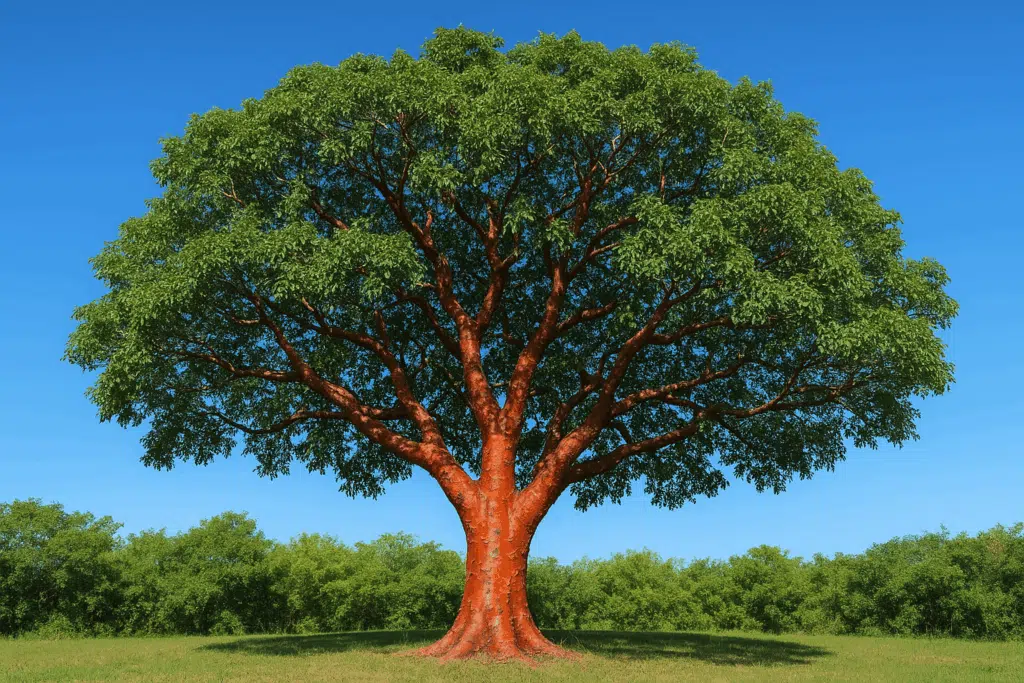When hurricane season approaches in Broward County, homeowners naturally worry about their landscape investments. While many non-native trees become liabilities during storms, there’s one remarkable Florida native that actually thrives in hurricane conditions: the Gumbo Limbo tree (Bursera simaruba). At Discount Tree Service, we’ve witnessed countless storm seasons and can confidently say that Gumbo Limbos are among the most resilient trees you can plant on your South Florida property.

Why Hurricane Resistance Matters in Broward County
Living in Broward County means accepting that hurricanes are part of life. The question isn’t whether storms will come, but when – and how prepared your landscape will be. Traditional landscape trees like ficus, Australian pines, and even some palm varieties often become dangerous projectiles during high winds. In contrast, hurricane-resistant native trees like the Gumbo Limbo can be your property’s best defense against storm damage.
Over our 25+ years serving Fort Lauderdale and surrounding areas, we’ve seen the aftermath of countless storms. Properties with well-chosen native trees consistently fare better than those planted with exotic species that can’t handle South Florida’s extreme weather conditions.
Meet the Gumbo Limbo: Nature’s Storm Survivor
The Gumbo Limbo, affectionately known as the “tourist tree” for its red, peeling bark that resembles a sunburned visitor, is one of South Florida’s most remarkable native species. This deciduous tree has evolved specifically to handle the challenges of our subtropical climate, including salt spray, flooding, drought, and yes – hurricanes.
Native Range and Natural Habitat
Gumbo Limbos naturally occur throughout South Florida, the Caribbean, and parts of Central America. In Broward County, you can find them in coastal hammocks, along waterways, and in areas that experience periodic flooding – environments that have shaped their incredible resilience.
Key Hurricane-Resistant Characteristics
Flexible Wood Structure
Unlike brittle trees that snap under pressure, Gumbo Limbos possess remarkably flexible wood. This flexibility allows the tree to bend dramatically in high winds without breaking. The wood’s elasticity is so pronounced that large branches can bend nearly to the ground and spring back unharmed once winds subside.
Strategic Branching Pattern
Gumbo Limbos develop an open, irregular branching pattern that allows wind to pass through the canopy rather than creating solid resistance. This natural “wind window” design significantly reduces the tree’s wind load during storms, making it far less likely to uproot or lose major limbs.
Rapid Regrowth Capability
Perhaps most remarkably, Gumbo Limbos can regenerate from almost any injury. Even if a hurricane strips away most branches or damages the trunk, these trees can regrow from remaining stumps or even large branch fragments. This regenerative ability means that even severely damaged trees often recover completely within a few growing seasons.
Deep and Spreading Root System
While many trees develop either deep taproots or shallow spreading roots, Gumbo Limbos develop both. This dual root strategy provides exceptional anchoring against uprooting while also allowing the tree to access water during both flood and drought conditions.
Planting Guidelines for South Florida Success
Soil Requirements
Gumbo Limbos are remarkably adaptable to Broward County’s diverse soil conditions. They thrive in:
- Sandy soils common near the coast
- Limestone-based soils found throughout much of the county
- Periodically flooded areas where other trees struggle
- Well-drained upland sites
The key is ensuring adequate drainage during the establishment period, even though mature trees can handle temporary flooding.
Best Planting Season
In Broward County, the optimal planting window for Gumbo Limbos is October through February. This timing allows trees to establish root systems during the cooler, drier months before facing their first summer heat and potential storm season.
Planting Specifications
Hole Preparation:
- Dig holes 2-3 times wider than the root ball
- Keep depth equal to the root ball height
- Avoid amending native soil unless drainage is severely compromised
Spacing Considerations:
- Allow 25-30 feet from structures for mature specimens
- Space multiple trees 20-25 feet apart for natural grove effect
- Consider overhead utility lines (mature height 25-40 feet)
Initial Care Requirements
Watering Schedule:
- Deep watering 2-3 times per week for first month
- Gradually reduce to weekly watering by month three
- Minimal irrigation needed after first year
Mulching:
- Apply 2-3 inch layer of organic mulch
- Keep mulch 6 inches away from trunk
- Refresh annually to suppress weeds and retain moisture
Ideal Placement for Maximum Benefits
Wind Protection Strategies
Windbreak Positioning: Position Gumbo Limbos on the southeast and east sides of your property to intercept prevailing hurricane winds. A single mature tree can provide significant wind protection for structures within a 100-foot radius.
Clustered Plantings: Plant multiple Gumbo Limbos in loose clusters rather than formal rows. This mimics their natural growth pattern and creates more effective wind disruption while providing mutual support during storms.
Aesthetic Integration
Landscape Design: Gumbo Limbos work beautifully as:
- Specimen trees in large yards
- Canopy trees in naturalized areas
- Background trees behind lower plantings
- Coastal buffers near waterfront properties
Utility Considerations
Always verify utility line locations before planting. While Gumbo Limbos rarely reach heights that interfere with power lines, proper planning prevents future tree trimming conflicts.
Maintenance Requirements & Care Tips
Pruning Needs
Gumbo Limbos require minimal pruning compared to most landscape trees. Focus on:
Structural Pruning (Years 1-5):
- Remove competing leaders
- Eliminate crossing branches
- Establish strong scaffold branch structure
Maintenance Pruning (Mature Trees):
- Remove dead or damaged wood annually
- Light crown cleaning every 3-5 years
- Avoid heavy pruning that stimulates excessive new growth
Fertilization Guidelines
Natural Fertility: Gumbo Limbos typically thrive without supplemental fertilization in most Broward County soils. Over-fertilizing can actually reduce their natural hurricane resistance by promoting rapid, weak growth.
When to Fertilize:
- Only if showing signs of nutrient deficiency
- Use slow-release, palm-specific fertilizers
- Apply in early spring if needed
Pest and Disease Management
Natural Resistance: One of the Gumbo Limbo’s greatest advantages is its natural resistance to most pests and diseases common in South Florida. This resistance reduces maintenance needs and eliminates the need for regular chemical treatments.
Occasional Issues:
- Scale insects (rarely serious)
- Caterpillar damage (temporary, tree recovers quickly)
- Root rot (only in poorly drained locations)
Companion Plantings for Multi-Layered Protection
Creating Storm-Resistant Plant Communities
Understory Trees:
- Firebush (Hamelia patens) – Native shrub that attracts butterflies
- Wild Coffee (Psychotria nervosa) – Shade-tolerant native
- Coontie (Zamia integrifolia) – Native cycad, extremely wind-resistant
Canopy Companions:
- Live Oak (Quercus virginiana) – Another hurricane-resistant native
- Bald Cypress (Taxodium distichum) – Excellent for wetter areas
- Mahogany (Swietenia mahagoni) – Native hardwood with good wind resistance
Ground Cover and Shrub Layer
Native Ground Covers:
- Beach Sunflower (Helianthus debilis) – Salt-tolerant, spreading ground cover
- Railroad Vine (Ipomoea pes-caprae) – Excellent for coastal areas
- Dune Sunflower (Helianthus debilis) – Drought and salt tolerant
This layered approach creates a natural ecosystem that provides multiple levels of wind protection while supporting local wildlife.
Growth Expectations & Mature Size
Growth Rate Timeline
Years 1-3:
- Establishment phase
- 3-5 feet of growth annually
- Focus on root development
Years 4-10:
- Rapid growth phase
- 4-6 feet annually under ideal conditions
- Canopy begins to develop characteristic shape
Years 10+:
- Mature growth phase
- 1-3 feet annually
- Full hurricane resistance achieved
Mature Specifications
Height: 25-40 feet (occasionally up to 60 feet in ideal conditions) Spread: 20-30 feet Trunk Diameter: 12-24 inches Lifespan: 50-100+ years with proper care
Seasonal Characteristics
Winter: Deciduous, drops leaves revealing attractive branch structure Spring: New leaf emergence with small, inconspicuous flowers Summer: Full, lush canopy providing excellent shade Fall: Gradual leaf drop, sometimes with yellow coloration
Where to Source Quality Specimens
Nursery Selection Criteria
Native Plant Specialists: Look for nurseries that specialize in Florida native plants. These suppliers understand proper propagation techniques and can provide locally-adapted specimens.
Container vs. Field-Grown:
- Container plants (3-7 gallon): Easier establishment, less transplant shock
- Field-grown specimens (larger sizes): More expensive but provide instant impact
Quality Indicators
Healthy Root Systems:
- Avoid pot-bound specimens
- Look for white, fibrous roots
- Reject plants with circling roots
Trunk and Branch Structure:
- Single, straight leader
- Well-spaced scaffold branches
- No mechanical damage or pruning wounds
Local Sources in Broward County
Many local nurseries now carry Gumbo Limbos due to increased interest in native, hurricane-resistant landscaping. Call ahead to check availability, as demand often exceeds supply during peak planting season.
Professional Tree Care Considerations
When to Consult Experts
While Gumbo Limbos are low-maintenance trees, certain situations warrant professional attention:
Installation on Large Properties: For significant landscape installations, professional tree service companies can ensure proper spacing, placement, and establishment care.
Storm Damage Assessment: Even hurricane-resistant trees can sustain damage. Professional arborists can assess whether damaged Gumbo Limbos should be preserved or require removal.
Integration with Existing Landscapes: Experienced tree care professionals can help integrate Gumbo Limbos into existing landscapes while considering mature size, root spread, and interaction with other plantings.
Ongoing Professional Services
Periodic Health Assessments: Annual inspections by certified arborists can identify potential issues before they become serious problems.
Structural Pruning: Young trees benefit from professional structural pruning to develop optimal hurricane resistance.
Emergency Services: Even the most hurricane-resistant trees occasionally require emergency tree services after severe storms.
Frequently Asked Questions
How long does it take for a Gumbo Limbo to become hurricane-resistant?
While young trees provide some wind resistance, full hurricane resistance typically develops after 5-7 years when the root system is well-established and the trunk has gained sufficient flexibility and strength.
Can Gumbo Limbos handle salt spray from the ocean?
Yes, Gumbo Limbos are naturally salt-tolerant and perform excellently in coastal environments. This makes them ideal for properties near the beach in areas like Fort Lauderdale, Hollywood, and Pompano Beach.
Do Gumbo Limbos attract any problematic pests?
Gumbo Limbos are remarkably pest-resistant. They rarely experience serious pest problems and don’t attract the destructive insects that plague many non-native landscape trees.
How much space do I need for a mature Gumbo Limbo?
Plan for a mature spread of 20-30 feet and plant at least 25 feet from structures. The root system typically extends slightly beyond the canopy drip line.
Are there any disadvantages to planting Gumbo Limbos?
The main considerations are:
- Deciduous nature (loses leaves in winter)
- Relatively slow establishment (2-3 years)
- Limited availability at some nurseries
- Not suitable for small urban lots due to mature size
Can I plant Gumbo Limbos near my pool or patio?
While possible, consider the seasonal leaf drop and plan for additional maintenance during winter months. The benefits often outweigh this minor inconvenience.
Do Gumbo Limbos need special permits in Broward County?
Generally no, but always check with your local municipality regarding tree planting regulations, especially for larger specimens or in historic districts.
Creating Your Hurricane-Resistant Landscape
The Gumbo Limbo tree represents everything we love about Florida’s native plants: beauty, resilience, and perfect adaptation to our unique environment. These remarkable trees don’t just survive hurricanes – they help protect your entire property while providing decades of natural beauty and environmental benefits.
At Discount Tree Service, we’ve seen how proper tree selection can make the difference between minor cleanup and major property damage after storms. Gumbo Limbos consistently prove themselves as one of the smartest landscape investments you can make in Broward County.
Whether you’re planning a new landscape, replacing storm-damaged trees, or simply want to increase your property’s hurricane resistance, consider adding these incredible native trees to your plans. Your future self – and your insurance company – will thank you.
Ready to enhance your landscape with hurricane-resistant native trees? Contact Discount Tree Service at (954) 289-2150 for expert guidance on tree selection, planting, and care. Our experienced team can help you create a beautiful, storm-resistant landscape that will thrive for generations.



